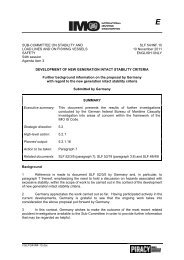Examination of the intact stability and the seakeeping behaviour
Examination of the intact stability and the seakeeping behaviour
Examination of the intact stability and the seakeeping behaviour
Create successful ePaper yourself
Turn your PDF publications into a flip-book with our unique Google optimized e-Paper software.
4.10 Vessel No. 10<br />
4.10 Vessel No. 10<br />
Figure 4.19: Lines plan <strong>and</strong> lateral areas <strong>of</strong> Vessel No. 10<br />
Table 4.19: Main dimensions <strong>of</strong> Vessel No. 10<br />
Main dimensions Value Unit<br />
L pp 195.40 [m]<br />
B 29.80 [m]<br />
T D 10.10 [m]<br />
Containers 2,478 [TEU]<br />
Vessel No. 10 has <strong>the</strong> geometric capacity to carry 2, 478 T EU. Having <strong>the</strong> main dimensions<br />
according to table 4.19, it is <strong>the</strong> smallest analysed vessel. In addition it is <strong>the</strong> only vessel equipped<br />
with cranes <strong>and</strong> a deck house located at <strong>the</strong> ship's aft end. The following characteristics <strong>of</strong><br />
Vessel No. 10 are to be noted:<br />
ˆ The lines <strong>of</strong> <strong>the</strong> ship shown in gure 4.19 have a c B value <strong>of</strong> 0.63 on design draft.<br />
ˆ The bilge keel area is not documented for this vessel <strong>and</strong> is estimated according to chapter<br />
3.9.<br />
ˆ The <strong>stability</strong> in ballast arrival loading condition is less high resulting in a GM solid = 5.95 m.<br />
ˆ The limiting <strong>intact</strong> <strong>stability</strong> criterion (Area (0, 40) = 0.090 m · rad) requires a<br />
GM min = 0.38 m.<br />
The calculated transversal accelerations on <strong>the</strong> bridge <strong>and</strong> <strong>the</strong> rolling angles for <strong>the</strong> three accident<br />
conditions are listed in table 4.20.<br />
Table 4.20: Results <strong>of</strong> <strong>the</strong> <strong>seakeeping</strong> calculation for Vessel No. 10<br />
Accident<br />
[<br />
a<br />
situation t max m/s<br />
2 ] ϕ max [ ◦ ]<br />
Situation 1 12.0 32<br />
Situation 2 14.5 43<br />
Situation 3 12.0 36<br />
The maximum acceleration <strong>of</strong> 14.5 m /s 2 occurs for accident situation 2 while <strong>the</strong> associated<br />
rolling angle <strong>of</strong> 43 ◦ is <strong>the</strong> highest calculated value in <strong>the</strong> whole examination. The statistical<br />
distribution <strong>of</strong> <strong>the</strong> transversal accelerations in this situation is shown in gure 4.20.<br />
33

















